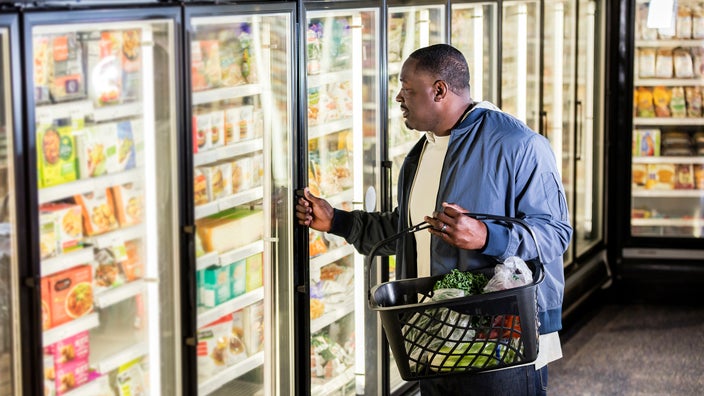
Should You Avoid Frozen Meals? A Dietitian’s Advice
Key takeaways:
Frozen meals can be a nutritious option, especially if they’re filled with vegetables, lean proteins, and whole grains.
Choose frozen meals that are made from whole foods. It’s best to limit ultra-processed frozen meals that contain additives like carrageenan, disodium inosinate, and sodium benzoate.
Some frozen meals have small portions and contain fewer than 200 calories. This is not enough for a satisfying, nutrient-dense meal. You can bulk up a small frozen meal by adding vegetables or another side dish to make it more complete.
Table of contents

With busy schedules and hectic lifestyles, sometimes coming up with nutritious meals requires shortcuts. Ordering takeout is an option, but that can be expensive, and may come with a hefty dose of salt or saturated fat. Another alternative is ready-made frozen meals.
Many frozen meals are tasty, affordable time-savers. Of course, the meals in the grocery store’s freezer section vary in their nutrient value. Some frozen meals are better for you than others. Here’s how to choose more nutritious frozen meals.
Are frozen meals bad for you?
Frozen meals are not necessarily bad for you. There are many frozen meals that offer tasty, nutrient-dense options that you can enjoy as part of a balanced diet.
Save over 40% on Qsymia with GoodRx
Discover the once daily Qsymia for weight management. Qsymia is for adults and children 12-17 in combination with a healthy diet and regular exercise.

Frozen meals have a bad reputation because many are high in unhealthy fat, salt, and additives. And in the past, many contained deep-fried ingredients (think fried chicken or battered fish). But frozen meal options have improved since they were introduced to the mainstream in the 1950s. Nowadays, you can find balanced meals that contain whole grains, lean protein, and vegetables.
Far from being bad for you, it turns out that freezing is an excellent way to safely preserve food to retain nutrients and reduce food waste. Freezing doesn’t alter the nutritional value of the meal’s macronutrient content — the proteins, carbohydrates, and fats contained in foods.
Plus, foods that are frozen retain lots of vitamins and minerals. In fact, some frozen foods, such as vegetables and beans, have even more vitamins and minerals than their fresh counterparts. That’s because they are frozen soon after harvest, which helps nutrients to be preserved.
Frozen meals also can bring wonderful variety to your diet. There are hundreds of frozen meal options to choose from, making frozen meals a great way to explore global cuisines and try new flavors. Everything from lasagna and burritos to pad thai and chicken tikka masala are available as frozen meals.
Frozen vs. fresh veggies: Frozen vegetables can be as healthy as fresh, and they may be an affordable, convenient way to help you eat more veggies overall.
Tips for avoiding processed foods: Making some truly simple swaps can help you reduce the amount of processed ingredients in your diet.
A dietician’s meal prep advice: Meal prepping can save you time and money, and can help you eat more nutritious foods. It’s also easier than you may think.
What makes frozen meals unhealthy?
There’s no blanket statement to be made about frozen meals. The nutritional value of a frozen meal really depends on the ingredients and cooking methods that are used. For example, a frozen meal consisting of grilled chicken, brown rice, and broccoli will be more nutritious than a frozen meal consisting of deep-fried chicken, buttery mashed potatoes, and apple pie.
Here are some of the things that can make frozen meals unhealthy.
Too much salt
Some frozen meals are very high in sodium, with many containing more than 2,000 mg of sodium per serving. The American Heart Association (AHA) recommends no more than 2,300 mg of sodium per day, so 2,000 mg is a lot of salt for one meal. Try to find frozen meals with less than 650 mg (29% DV) of sodium per serving.
Too few calories
The serving size on some frozen meals is very small. For context, a typical meal usually has 500-800 calories. (This is an average estimate. Everyone’s calorie needs are different, so some people may need more than this at a meal.) But some frozen meals have closer to 190 calories per serving. A meal with so few calories won’t fill you up or provide the full amount of nutrients your body needs. It may be best to enjoy those low-calorie options as a snack rather than a meal. Or, eat them as part of your meal, but with added side dishes, to ensure you’re satisfied.
Lack of veggies
Some frozen meals are low in vegetables. The USDA’s My Plate meal guidelines recommend that half of your plate consist of vegetables and fruits. Some frozen meals may fall short of this goal, which means your meal may lack key nutrients, such as fiber, vitamins, and minerals. If a meal is low in vegetables, there are some easy remedies:
Add a side salad.
Enjoy sliced vegetables as a side dish.
Have fruit for dessert.
Heat up some extra frozen vegetables when you heat the frozen meal.
Read more like this
Explore these related articles, suggested for readers like you.
Starchy sides
It’s common for frozen meals to include a starchy side dish, such as refined white rice or pasta. But fiber-rich whole grains are a more nutritious option than refined grains. They contain more fiber, antioxidants, vitamins, and minerals than refined grains. Look for frozen meals that include whole grains such as brown rice or whole wheat pasta.
What to avoid when shopping in the frozen food section
Ideally, you want your frozen meal to contain similar ingredients to what you would cook at home. Frozen meals made with a lot of additives, preservatives, and thickeners don’t check this box. Instead, they fall into the category of ultra-processed food.
Studies show that a high intake of ultra-processed foods is linked to an increased risk of heart disease, Type 2 diabetes, and some types of cancer. It’s better to choose whole foods (even if frozen) rather than ultra-processed foods.
Read the ingredient list on your frozen dinner packaging. If it contains the following ingredients, skip it and keep shopping for a better option:
Disodium phosphate
Sodium lactate
Sodium phosphate
Xanthan gum
Sodium benzoate
Carrageenan
Gum acacia
Maltodextrin
Modified food starch
Disodium inosinate
Disodium guanylate
None of these ingredients are harmful on their own, and a little bit is fine, on occasion. But if many of your meals contain these additives, over time your high intake of ultra-processed foods may harm your health.
There are some frozen meals that mimic home-cooked recipes and don’t contain a list of additives. Read ingredient lists to know for sure. Look for frozen dinners made from whole foods, which have an ingredient list that contain familiar foods that you’d have in your own kitchen. It may look like this:
Tofu, tomato puree, sweet potatoes, broccoli, garbanzo beans, quinoa, onions, olive oil, vinegar, cilantro, salt, garlic, brown sugar, spices.
More nutritious frozen meal options
There are many healthy frozen meals in your grocery store freezer. To choose wisely, read ingredients lists and nutrition facts tables. Look for meals that:
Contain vegetables — the more veggies, the better
Are made with whole grains, such as brown rice, whole-wheat pasta, or quinoa
Contain a source of protein, which may be plant-based (tofu, beans) or animal-based (chicken, shrimp). At least 20 g protein per meal is ideal.
Have less than 650 mg sodium (29% DV) per serving
Have less than 20% DV saturated fat per serving
Contain enough calories to satisfy your appetite
Are mostly made from whole foods and have minimal additives or ultra-processed ingredients
The bottom line
Frozen meals are a convenient option, and can be nutritious if you know what to look out for — and what to avoid. Many frozen meals are created from whole foods and use vegetables, whole grains, and lean protein as the main ingredients.
Read packages carefully, and choose meals that don’t contain additives, preservatives, and thickeners. And try something new! The variety of frozen meals is impressive. You can dine on a range of different global cuisines and delicious flavors.
Why trust our experts?



References
American Heart Association. (2024). How much sodium should I eat per day?
Biakolo, K. (2020). A brief history of the TV dinner. Smithsonian Magazine.
Bouzari, A., et al. (2015). Vitamin retention in eight fruits and vegetables: A comparison of refrigerated and frozen storage. Journal of Agricultural and Food Chemistry.
Delpino, F. M., et al. (2022). Ultra-processed food and risk of type 2 diabetes: A systematic review and meta-analysis of longitudinal studies. International Journal of Epidemiology.
Ellis, E. (2022). Frozen foods: Convenient and nutritious. EatRight.org.
Isaksen, I.M., et al. (2023). Ultra-processed food consumption and cancer risk: A systematic review and meta-analysis. Clinical Nutrition.
Schoenfeld, B. J., et al. (2018). How much protein can the body use in a single meal for muscle-building? Implications for daily protein distribution. Journal of the International Society of Sports Nutrition.
Srour, B., et al. (2019). Ultra-processed food intake and risk of cardiovascular disease: Prospective cohort study (NutriNet-Santé). British Medical Journal.
U.S. Department of Agriculture. (2013). Freezing and food safety.
U.S. Department of Agriculture. (2020). Dietary guidelines for Americans, 2020-2025.





























